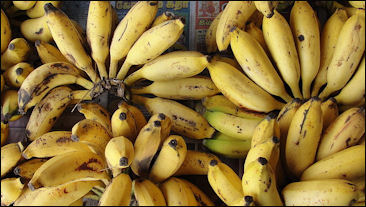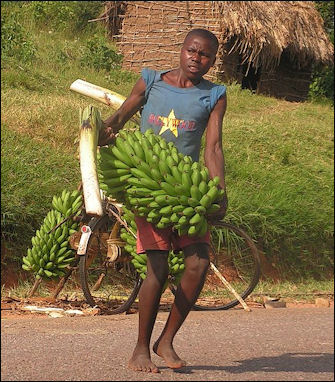BANANAS
Bananas are the world’s No.4 dietary staple after rice, wheat and corn. Hundreds of millions of people eat them. They are the most widely eaten fruit in the United States (Americans eat 26 pounds of them a years, compared to 16 pounds of apples, the No.2 fruit). More importantly they are a major source of food and staple of people in tropical areas and the developing world.
Of the nearly 80 million tons of bananas produced around the world less than 20 percent are exported. The rest are eaten locally. There are many places in sub-Sahara Africa where people eat bananas and little else. According to Islamic tradition the banana is the food of paradise.
Bananas, known by the scientific name “Musa sapientum” , are rich in vitamins A, B, C and G. Although they are 75 percent water they also contain alkali-forming minerals, lots of potassium, natural sugars, protein and little fat. They are easy to digest and the food of choice of many professional athletes when they are competing because they provide quick energy and provide potassium lost during exercise.
Bananas are not only a delicious fruit when ripe. In many places green bananas are also part of some dishes. Banana flower is mixed in delicious salads. Banana tree trunks, when young, can be eaten as a vegetable, and banana tree roots can be cooked with fish, or mixed in salads. There are many banana varieties. Bananas that are eaten raw ripe are called desert bananas; those that are cooked are called plantains. Ripe yellow bananas are 1 percent starch and 21 percent sugar. They are easier to digest than green bananas, which are 22 percent starch and 1 percent sugar. Green bananas are sometimes gassed to make them yellow prematurely
Websites and Resources: Banana.com: banana.com ; Wikipedia article Wikipedia ;
World’s Top Banana Producing Countries

Banana production by nation World’s Top Producers of Bananas (2020): 1) India: 31504000 tonnes; 2) China: 11513000 tonnes; 3) Indonesia: 8182756 tonnes; 4) Brazil: 6637308 tonnes; 5) Ecuador: 6023390 tonnes; 6) Philippines: 5955311 tonnes; 7) Guatemala: 4476680 tonnes; 8) Angola: 4115028 tonnes; 9) Tanzania: 3419436 tonnes; 10) Costa Rica: 2528721 tonnes; 11) Mexico: 2464171 tonnes; 12) Colombia: 2434900 tonnes; 13) Peru: 2314514 tonnes; 14) Vietnam: 2191379 tonnes; 15) Kenya: 1856659 tonnes; 16) Egypt: 1382950 tonnes; 17) Thailand: 1360670 tonnes; 18) Burundi: 1280048 tonnes; 19) Papua New Guinea: 1261605 tonnes; 20) Dominican Republic: 1232039 tonnes:
; [Source: FAOSTAT, Food and Agriculture Organization (U.N.), fao.org. A tonne (or metric ton) is a metric unit of mass equivalent to 1,000 kilograms (kgs) or 2,204.6 pounds (lbs). A ton is an imperial unit of mass equivalent to 1,016.047 kg or 2,240 lbs.]
World’s Top Producers (in terms of value) of Bananas (2019): 1) India: Int.$10831416,000 ; 2) China: Int.$4144706,000 ; 3) Indonesia: Int.$2588964,000 ; 4) Brazil: Int.$2422563,000 ; 5) Ecuador: Int.$2341050,000 ; 6) Philippines: Int.$2151206,000 ; 7) Guatemala: Int.$1543837,000 ; 8) Angola: Int.$1435521,000 ; 9) Tanzania: Int.$1211489,000 ; 10) Colombia: Int.$1036352,000 ; 11) Costa Rica: Int.$866720,000 ; 12) Mexico: Int.$791971,000 ; 13) Vietnam: Int.$780263,000 ; 14) Rwanda: Int.$658075,000 ; 15) Kenya: Int.$610119,000 ; 16) Papua New Guinea: Int.$500782,000 ; 17) Egypt: Int.$483359,000 ; 18) Thailand: Int.$461416,000 ; 19) Dominican Republic: Int.$430009,000 ; [An international dollar (Int.$) buys a comparable amount of goods in the cited country that a U.S. dollar would buy in the United States.]
Top Banana Producing Countries in 2008: (Production, $1000; Production, metric tons, FAO): 1) India, 3736184 , 26217000; 2) China, 1146165 , 8042702; 3) Philippines, 1114265 , 8687624; 4) Brazil, 997306 , 6998150; 5) Ecuador, 954980 , 6701146; 6) Indonesia, 818200 , 5741352; 7) United Republic of Tanzania, 498785 , 3500000; 8) Mexico, 307718 , 2159280; 9) Costa Rica, 295993 , 2127000; 10) Colombia, 283253 , 1987603; 11) Burundi, 263643 , 1850000; 12) Thailand, 219533 , 1540476; 13) Guatemala, 216538 , 1569460; 14) Viet Nam, 193101 , 1355000; 15) Egypt, 151410 , 1062453; 16) Bangladesh, 124998 , 877123; 17) Papua New Guinea, 120563 , 940000; 18) Cameroon, 116858 , 820000; 19) Uganda, 87643 , 615000; 20) Malaysia, 85506 , 600000
Banana Plant
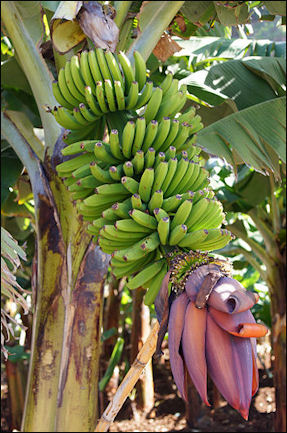
Bananas come from a herbaceous plants, not trees, that look like a palms but are not palms. Capable of reaching a height of 30 feet but generally much shorter than that, these plants have stalks made of leaves that overlap one another like a celery not woody trunks like trees. As the plant grows the leaves sprout from the top of the plant like a fountain, unfurl and drop downwards like palm fonds.
A typical banana plant has 8 to 30 torpedo-shaped leaves that are up to 12 feet long and 2 feet wide. New leaves growing up from he center of the plant force the older leaves outward, enlarging the stalk. When a stalk is fully grown, it is from 8 to 16 inches thick, and soft enough to be cut with a bread knife.
After the leaves unfurl, the banana’s true stem — a green, fibrous extrusion, with a softball-size magenta bud at the end — emerges. As the stem grows the cone-shaped bud at the top weighs it down. Petal-like bracts grow between the overlapping scales surrounding the bud. They fall away, revealing clusters of flowers. Oblong fruit emerge from the base of the flowers. The tips of the fruit grow towards the sun, giving bananas their distinctive crescent shape.
Each plant produces a single stem. Banana clusters that grow from the stem are called "hands." Each stem contains six to nine hands. Each hand contains 10 to 20 individual bananas called fingers. Commercial banana stems produces six or seven hands with 150 to 200 bananas.
A typical banana plant grows from a baby to the size in which the fruit are harvested in nine to 18 months. After the fruit is removed the stalk dies or is cut down. In its place one of more “daughters” sprout as suckers from the same underground rhizome that produced the mother plant. The suckers, or sprouting corms, are genetic clones of the parent plant. The brown dots in ripe bananas are undeveloped ovules that are never fertilized by pollination. The seeds never develop.
Plantains
Plantains (cooking bananas) are a staple in Latin America, the Caribbean, Africa and parts of Asia. They look like bananas but are slightly larger and have angular faceted sides. Originally from Southeast Asia, plantains are higher in potassium, vitamin A and vitamin C than bananas. Some varieties reach lengths of two feet and are as thick as a man's arm. [Source: Amanda Hesser, New York Times, July 29, 1998]
Harvested when green and firm, plantains have a starchy interior similar to that of a potato. They are not pealed down like bananas. The peals are best removed by prying and pulling across after slits have been made on the vertical ridges. A typical dish in Africa and Latin America is chicken with plantains.
Plantains are prepared hundreds of different ways that often indigenous to a specific country or area. They can be boiled or baked but mostly they are sliced and fried as fritters or chips. Plantains that have yellowed are sweeter. These one or boiled, mashed, sauteed or baked. Fully ripened plantains are black and shriveled. They are usually made into mash.
Fruits and Vegetables
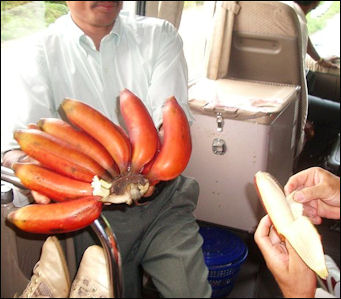
Plantains Air freight, refrigerated containers, specialized packing has meant that perishable fruits and vegetable can make it to supermarkets in the United States and Japan from Chile and New Zealand without spoiling.
The world price for commodities is often set as much by speculation as it is by production, demand and supply.
Antioxidants found in red wine, fruits and vegetables and tea counter the effects of free radicals, unstable atoms that attack human cells and tissues and have been linked to ageing and a range of ailments, including Parkinson’s disease, cancer and heart disease. Fruits and vegetables with rich colors often get their colors from antioxidants.
Using genetic engineering and other means, farmers and scientists at Hazera Genetics, established at a former kibbutz in Berurim Israel, have created lemon-scented tomatoes, chocolate-colored persimmons, blue bananas, round carrots and elongated strawberries as well as red peppers with three times as much vitamins as normal ones and black chickpeas with extra antioxidants. Their yellow-skinned cherry tomatoes are a big hit in Europe, where the seeds sell for $340,000 a kilogram.
Book: “Uncommon Fruits and Vegetables” by Elizabeth Schneider (William Morrow, 1998); “Random House Book of vegetables” by Roger Phillips and Martyn Rix
Varieties of Bananas
There are over hundred different varieties of banana. They have names like Pelipita, Tomola, Red Yade, Poupoulou, and Mbouroukou. Some are long and skinny; others are short and squat. Many are only tended locally because they bruise easily. Reddish bananas, known as palle bananas and red orinocos, are popular in Africa and the Caribbean. Tiger plantains are dark green with white stripes. Bananas know as “maantoke” are eaten raw and cooked in porridge and fermented into banana beer in Uganda, Rwanda, Burundi and other places in sub-Sahara Africa. Africans eat hundreds of pounds of these a year. They are such a vital source of food that in many in Africa mantooke simply means food.
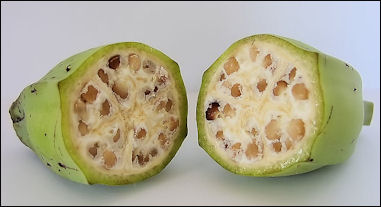
Inside a wild-type bananaThe Cavendish is the long, golden-yellow variety most commonly sold in stores. They have good color; are uniform in size; have a thick skin; and are easy to peel. Banana afficionados complain their taste is bland and sweet. The “Gros Michel” (meanings "Big Mike") was the most common supermarket variety until the 1950s when crops worldwide were wiped out by the Panama disease. The Cavendish was unaffected by the disease and emerged as No. 1 export banana. But it too is vulnerable to diseases, It produces no seeds or pollen and can no be bred to improve it resistance. Many believe it too will one day be wiped out by a devastating disease.
The Canary island banana, also known as the dwarf Chinese banana, is grown in many places because of its resistance to soil disease. Small varieties include "Manzaonos” , mini bananas and Ladyfingers from the Canary Islands that are only three to four inches long. Other popular varieties include the greenish-yellow Laeatan from the Philippines, the Champa of India, the dry-textured Maritu, an orange plantain from New Guinea and the Mensaria Rumph, a variety from Malaysia that smells like rosewater.
In Vietnam Tieu bananas are the most popular kind; they are small and smell sweet when ripe. Ngu and Cau bananas are small with a thin peel. Tay bananas are short, big, and straight, and can be fried or cooked in meals. Tra Bot bananas are widely planted in the south; their peel is yellow or brown when ripe with a white pulp. When Tra Bot bananas are not ripe, they taste sour. In the Southeast, there are a lot of Bom bananas. They look like Cau bananas, but their peel is thicker and their pulp is not as sweet.
Early Bananas
All bananas eaten today are descendants of two kinds of wild fruit: 1) the "Musa acuminta” , a plant originally from Malaysia that produces single sweet-pickle-size green fruit that have a milky flesh and several hard peppercorn-size seeds inside; and 2) the "Musa balbisiana” , a plant originally from India that is larger and more robust than "M. acuminata” and produces more fruit with thousands of round, button-like seeds. About half the genes found in bananas are also found in humans.
Wild bananas are pollinated almost exclusively by bats. The tubular flowers are produced on a dangling stalk. The flowers at the top are initially all female. Those running down the sides are males. The seeds are dispersed by animals that eat the fruit. When the seeds are developing the fruit tastes bitter or sour because the undeveloped seeds are not ready for animals to eat. When the seeds are fully developed the fruit changes color to signal it is sweet and ready for animals to eat — and the seeds are ready to be dispersed.
Thousands of yeas ago acuminata and balbisiana crossed fertilized, producing natural hybrids. Over time, random mutations produces plants with seedless fruit that were more edible than seed-filled varieties so people ate them and cultivated them. In this way mankind and nature worked side by side to produce sterile hybrids that are incapable of reproducing sexually but constantly produce new generations of daughter plants by suckering from a long-living rhizome that lives underground.
Early Banana History

banana transport in Jamaica in 1894 Bananas may be the world’s oldest cultivated crop. There is evidence that bananas were cultivated in the highlands of New Guinea at least 7,000 years ago and that Musa varieties were being bred and grown in the Mekong Delta area of Southeast Asia as long as 10,000 years ago.
Wild bananas can be found in the wet hot forests of New Guinea and South and Southeast Asia, Phytoliths of cultivated bananas appear at Kuk Swamp in Papua New Guinea around 6,800 years ago. How they spread into the wider world has not been clear. Other early dates for bananas include 5,250 years ago for those from Munsa, Uganda, and 4,250 years ago for those from Kot Diji in Pakistan. [Source: Chris Hunt, Professor of Cultural Palaeoecology, LJMU; / Dr Rathnasiri Premathilake, Senior Lecturer in Environmental Archaeology, University of Kelaniya, July 30, 2018}
The abstract of a 2003 article in Science reads: Multidisciplinary investigations at Kuk Swamp in the Highlands of Papua New Guinea show that agriculture arose independently in New Guinea by at least 6950 to 6440 years ago. Plant exploitation and some cultivation occurred on the wetland margin at 10,220 to 9910 years ago (phase 1), mounding cultivation began by 6950 to 6440 years ago (phase 2), and ditched cultivation began by 4350 to 3980 years ago (phase 3). Clearance of lower montane rainforests began in the early Holocene, with modification to grassland at 6950 to 6440 years ago Taro (Colocasia esculenta) was utilized in the early Holocene, and bananas (Musa spp.) were intensively cultivated by at least 6950 to 6440 years ago [Source: Origins of Agriculture at Kuk Swamp in the Highlands of New Guinea [Source: “Origins of Agriculture at Kuk Swamp in the Highlands of New Guinea” by T. P. Denham, S. G. Haberle, C. Lentfer, R. Fullagar, J. Field, M. Therin, N. Porch, and B. Winsborough, Science July 11 2003, Vol 301, Issue 5630, pp. 189-193]
In the first or second millennium B.C. Arab traders carried banana suckers from Southeast Asia back home and introduced the fruit to the Middle East and the east coast of Africa. Swahili people from the coast of Africa traded the fruit with Bantu people from the interior of Africa and they carried the fruit to western Africa. The introduction of the banana to Africa occurred so long ago that areas of Uganda and the Congo basin have become secondary centers of genetic diversity.
According to Archaeology magazine: Experts were stunned to find evidence that Bronze Age inhabitants of Tel Megiddo and Tel Erani in present-day Israel had access to exotic foodstuffs from the Far East. Trace amounts of turmeric, soybeans, and bananas were detected in the dental plaque of people who lived in the Levant 3,700 years ago. This is the earliest evidence of these products found outside southern Asia and demonstrates that trade routes between Asia and the Mediterranean date back centuries earlier than previously thought. [Source: Archaeology magazine, March-April 2021]
Later Banana History
Bananas were discovered by the Portuguese on the Atlantic coast of Africa. They cultivated the fruit on the Canary Islands. From there it was introduced to the Americas by Spanish missionaries. Documenting the arrival of bananas in the New World a Spanish historian wrote: “This special kind [of fruit] was brought from the Island of Gran Canaria in the year 1516 by the Reverend Father Friar Tomas de Berlandga...to the city of Santa Domingo whence the spread to the other settlements on this island [of Hispaniola]...And have been carried to the mainland, and in every part they have flourished.”
Americans have only been eating bananas since the 19th century. The first bananas marketed in the United States were brought from Cuba in 1804. For many years they were regarded as a novelty. The first large shipments were brought from Jamaica in the 1870s by Lorenzo Dow Bake, a Cape Cod fishemen who later founded the Boston Fruit Company which became the United Fruit Company.
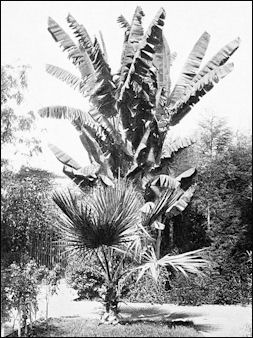
Banana tree in Indonesia Panama disease ravaged Caribbean and Central American banana plantations in the 1940s and 1950s, resulting in the Gros Michel variety being virtually wiped out and replaced by the Cavendish type. Gros Michels were tough. Enormous bunches of them could carried untouched from plantations to stores. Cavendish are more fragile. Plantation owners had to build packing houses where the bananas could be broken down into bunches and placed in protective boxes. The transition to the new banana cost millions and took more than a decade to complete.
The “banana wars” lasted for 16 year and won the distinction of being the world’s longest trade dispute. It finally ended in 2010 with a deal between the European Union and Latin America, and was approved by African, Caribbean and Pacific countries and the United States. Under the deal duties would be lowered from $176 a ton in 2010 to $114 a ton in 2016.
Uses of Bananas
Bananas are eaten raw, dried or cooked in a variety of ways. Unripened bananas are rich in starch and sometimes dried and ground into flour, which is used in bread, baby foods and special foods. Flowers from certain bananas are considered a delicacy in some parts of India. They are usually cooked in curries.
Banana leaves are also used as umbrellas, mats, roofing and even as clothing. In tropical countries they used wrap food sold on the streets. The fiber of the plant can be wound into twine.
Japanese paper companies are working in some developing countries to help banana farmers make paper from banana fibers. This helps the farmers to dispose of the large amounts of fiber waste created when growing bananas and reduces the need to chop down forests.
Banana Agriculture

Banana street snack Banana plants are grown from rhizomes, underground stems that grow sideways rather than down and have roots of its own. As the plant grows, shoots or suckers develop around the original stalk. The plant is pruned so that only one or two plants are allowed to develop. These successively replace the plants that have borne fruit and have been cut down. Each rootstock generally produces one plant each season but continues producing plants until it dies.
The original fruit-bearing plant is called the "mother." After harvesting, it is cut down and a plant. called a daughter or ratoon ("follower”), grows from the same roots as the mother. There may be several daughters. Many places harvest the third daughter, plow and replant a new rhizome.
A banana tree can grow 10 feet in four months and bear fruit in as little as six months after planting. Each tree produces only one banana-producing stem. In three or four weeks a single green leaf sprouts from each rootstock. After nine to ten months the stem at the center of the stalk blossoms. Soon the flower bends over and hangs downward. After the petals drop, tiny bananas are revealed. At first the bananas point towards the ground. As they grow they turn upwards.
Banana plants require rich soil, nine to 12 months of sunshine and frequent heavy rains adding up to 80 to 200 inches a year, generally more than can be provided by irrigation. Bananas are either spayed with pesticides or wrapped in plastic for protection from insects. Wrapping the fruit also prevents it from being bruised by leaves in windy conditions. The soil around the bananas must constantly be cleared of weeds and jungle growth.
Many poor villagers like bananas because the trees grow fast and bear fruit quickly, for highest profits. Sometimes banana plants are used as shade for crops like cacao or coffee.
Banana Harvesting and Processing
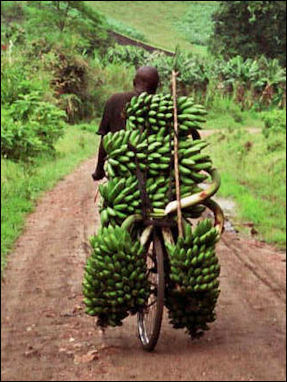
Banana carrier in Uganda Bananas are picked green and gassed to make them yellow. If they weren’t picked green they would spoil by the time they reached the markets. Bananas that are left to ripen on the tree are "full of water and taste bad."
Harvesting takes place about a year after the plants sprout up from the earth. When they are cut the banana stems can weigh between 50 and 125 pounds. In many places harvesting bananas is done by pairs of workers. One person cuts the stalk with a knife-tipped pole and a second person catches the bunches on his back when the fall so the bananas are not bruised and the skin is not damaged. .
After the harvest the entire plant is cut down and a new plants springs up from the root the next year like a tulip. New shoots often spring out of old desiccated plants. The Africans have a proverb used to accept death and immortality goes: "When the plant dies; the shoot grows." One of the main problems with banana farming is what to do plants after they are cut down.
After they are harvested the bananas are carried on a wire trolleys, mule carts, tractor-drawn trailers, or narrow gage railroads to sheds where they are washed in water tanks to minimize bruising, wrapped in plastic, graded and boxed. The stem are dipped into sealing chemicals to prevent insects and other pests from entering. After being processed in the sheds bananas are often carried by narrow-gauge railroads to the seacoast to be loaded on refrigerated ships that keep the bananas green while they are transported abroad. The temperatures on the ships is usually between 53̊F and 58̊F. If the weather outside the ship is cold, the bananas are heated with steam. Upon arrival at their destination, the bananas are ripened in special ripening rooms with temperatures between 62̊F and 68̊F and humidity between 80 and 95 percent and then transported to the stores where they are sold.
Banana Plantations
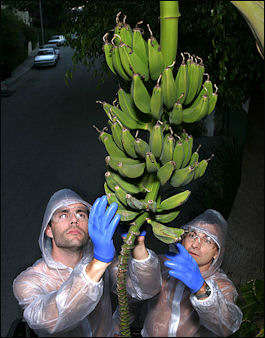
In many parts of the world, bananas have traditionally been raised on vast plantation, where banana plants spread out in every direction as far as the eye can see. To be profitable the plantations have to access to roads or railroads that carry the bananas to seaports for transportation overseas.
Banana cultivation is a labor intensive industry. Plantations often require hundreds or thousands of workers, who have traditionally been paid very low wages. Many plantations provide housing, water, electricity, schools, churches and electricity for their workers and their families.
Banana plants are planted in rows spaced 8 feet by 4 feet, which allows 1,360 trees per acre. Ditches are built to drain the water from heavy rains. Although banana plants can grow as high as 30 or 40 feet, most plantation owners prefer short plants because they don't blow down in storms and are easier to harvest fruit from.
The plantation have been accused of using child labor and paying their workers a pittance for wages. This is particularly a problem in Ecuador. In some places workers unions are fairly strong. With union contracts, workers often work eight-hour days, receive decent wages, adequate housing and health and safety protections.
Problems with Bananas
Bananas vulnerable to weather and disease. Banana plants blow over easily and can easily be destroyed by hurricanes and other storms. They are also attacked by a wide variety of pests and diseases.
Two serious diseases that threaten bananas are: 1) black sigatoka, a leaf-spotting disease caused by a wind-borne fungus that is usually controlled by aerial spray of pesticides from helicopters, and 2) Panama disease, an infection in the soil that is controlled by growing varieties that are resistant to the disease. Among the other diseases that threaten banana crops are the bunchy-top virus, fusarium wilt and cigar-end rot. The plants are also attacked by weevils and worms.
Black sigatoka is named after an Indonesian valley where it first appeared. It attacks the leaves of the banana plant, inhibiting the plant’s ability to photosynthesize, and can ruin entire crops in a short period of time. The disease has spread throughout Asia, Africa and Latin America. Many species are vulnerable to it, particularly the Cavendish. Black sigatoka and other diseases have decimated banana crops in east and west-central Africa, reducing banana yields by up to 50 percent. The disease has become such as problem that fighting it in now accounts for about 30 percent of Chiquita’s costs.

Panama disease wiped out the Gros Michels bananas in the 1940s and 1950s but left the Cavnedish relatively untouched. A new more virulent strain of Panama disease known as Tropical race 4 has emerged that kill Cavnedish bananas as well as many other varieties. No known pesticide can stop it for long. Tropical 4 first showed up in Malaysia and Indonesia and has spread to Australia and southern Africa. As of late 2005 central and western Africa and Latin America had not yet been struck.
Sometimes very strong chemicals are used to combat the various pests that threaten bananas. DBCP, for example, is a powerful pesticide that is used to kill a microscopic worm that would prevent the export of bananas to the United States. Even after DBCP was banned in the United States in 1977 because it was linked to sterility in men at a California chemical plant, companies like Del Monte Fruit, Chiquita Brands and Dole Food continued to use it in 12 developing countries.
The Caribbean islands of Guadeloupe and Martinique face a health disaster in which one man in two is likely to get prostrate cancer as a result of long-term exposure to the illegal pesticide Chlordecone . Used to kill weevils, the chemical was outlawed on the island in 1993 but was used illegally until 2002. It remains in the soil for more than a century and contaminates ground water.
Banana Technology
Major banana research centers include the African Research Center on Bananas and Plantains (CARBAP) near Njombe in Cameroon, with one of the world’s largest field collections of bananas (more than 400 varieties grown in neat roads); and Catholic University of Leuven in Belgium, with largest collection banana varieties in form of seeds and bean-sprout plantlets, stored in capped test tubes.
The Honduran Foundation for Agricultural Research (FHIA) is a leading banana breeding center and the source of many promising hybrids such as FHIA-02 and FHIA-25 which can beecooked when green like plantains and eaten like bananas when they are ripe. FHIA-1, also known as Goldfinger, is a disease-resistant sweet banana that may challenge the Cavendish.
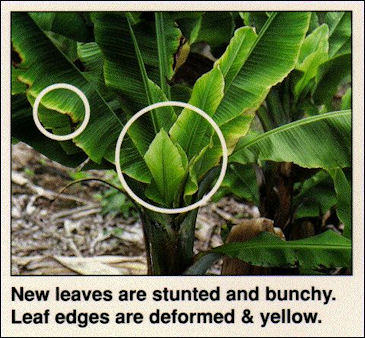
Bunch Top virus The goal of banana scientists is to produce pest- and disease-resistant plants that grow well in a variety of conditions and produce fruits that consumers enjoy eating. One of the most difficult obstacles to overcome is to produce crosses between plant that can’t reproduce. This is achieved by uniting many pollen-bearing male flower parts with seed-bearing fruits that can be found on plants that have desired traits that want to be develop.
Banana hybrids are created by collecting as much pollen as possible from a male parent and using that to fertilize flowering female parents. After four or five months fruit are produced and they pressed in a sieve to retrieve the seeds, A ton of fruit may yield only a handful of seeds. These are allowed to germinate naturally. After nine to 18 months the plant matures, ideally with the characteristic you want. Developing a hybrid that makes it to the market place can take decades.
Scientists are working on genetically-engineered bananas that will rot more slowly and developing dwarf hybrids that produce large amounts of fruit for their weigh, are easy to work, and don’t blow over in storms. A variety called Yangambi Km5 shows great promise. It is tolerate to a number of pests and produces large amount of fruit with a creamy sweet flesh and is fertile,, Currently its thin skin make it difficult to peel and is fragile when shipped. It is currently being crossed with thick-skinned varieties to make a tougher when shipped.
Genetically engineered disease-free bananas have been a boon to farmers in Africa.
Banana Producers
Bananas are the No. 1 fruit export in the world. The worldwide trade of bananas is worth $4 billion a year. About 80 million tons of bananas produced around the world. Less than 20 percent is exported, with 15 percent are exported to the United States, Europe and Japan.
Bananas have traditionally been a cash crop for banana companies in Central America, northern South America, and the islands of the Caribbean. In 1954, the price of bananas rose so high it was called "green gold." Today bananas are grown in 123 countries.
India, Ecuador, Brazil and China collectively produce half the world’s banana crop. Ecuador is the only leading producer that is oriented towards producing bananas for the export market. India and Brazil, the world’s leading producers, export very little.
Worldwide more and more countries are raising bananas which means the price is getting lower and lower and smaller producers have a rougher time. Since 1998, worldwide demand has dropped. This has led to overproduction and a further drop in prices.
Banana Companies
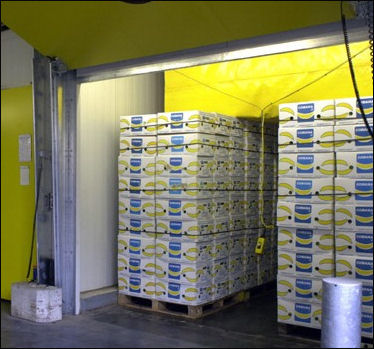
refrigeration rooms The "Big Three” banana companies — Chiquita Brands International of Cincinnati, Dole Food Company of Westlake Village California; Del Monte Products of Coral Gables, Florida — control about two thirds of the world banana export market. The Europe giant Fyffes controls much of the banana trade in Europe. All of these companies have long family traditions.
Noboa, whose bananas are sold under the “Bonita” label in the United States, in recent years has grown to become the world’s forth largest banana producer. It dominates the market in Ecuador.
Banana Consumers
Importers: 1) the United States; 2) European Union; 3) Japan
Americans eat an average of 26 pounds of bananas a year. In the 1970s Americans ate an average of 18 pounds of bananas a year. Most bananas and banana products sold in the United States come from South and Central America.
In Uganda, Rwanda and Burundi people eat around 550 pounds of bananas a year. They drink banana juice and beer made from bananas.
World’s Top Banana Exporting Countries
World’s Top Exporters of Bananas (2020): 1) Ecuador: 7039839 tonnes; 2) Costa Rica: 2623502 tonnes; 3) Guatemala: 2513845 tonnes; 4) Colombia: 2034001 tonnes; 5) Philippines: 1865568 tonnes; 6) Belgium: 1006653 tonnes; 7) Netherlands: 879350 tonnes; 8) Panama: 700367 tonnes; 9) United States: 592342 tonnes; 10) Honduras: 558607 tonnes; 11) Mexico: 496223 tonnes; 12) Côte d'Ivoire: 346750 tonnes; 13) Germany: 301383 tonnes; 14) Dominican Republic: 268738 tonnes; 15) Cambodia: 250286 tonnes; 16) India: 212016 tonnes; 17) Peru: 211164 tonnes; 18) Belize: 203249 tonnes; 19) Turkey: 201553 tonnes; 20) Cameroon: 180971 tonnes ; [Source: FAOSTAT, Food and Agriculture Organization (U.N.), fao.org]
World’s Top Exporters (in value terms) of Bananas (2020): 1) Ecuador: US$3577047,000; 2) Philippines: US$1607797,000; 3) Costa Rica: US$1080961,000; 4) Colombia: US$913468,000; 5) Guatemala: US$842277,000; 6) Netherlands: US$815937,000; 7) Belgium: US$799999,000; 8) United States: US$427535,000; 9) Cote d’Ivoire: US$266064,000; 10) Honduras: US$252793,000; 11) Mexico: US$249879,000; 12) Germany: US$247682,000; 13) Cameroon: US$173272,000; 14) Dominican Republic: US$165441,000; 15) Vietnam: US$161716,000; 16) Panama: US$151716,000; 17) Peru: US$148425,000; 18) France: US$124573,000; 19) Cambodia: US$117857,000; 20) Turkey: US$100844,000
World’s Top Banana Importing Countries
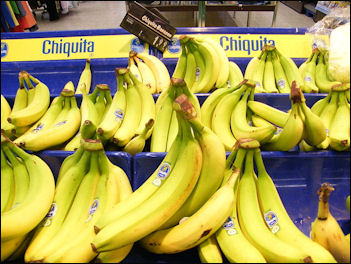
Chiquita bananas World’s Top Importers of Bananas (2020): 1) United States: 4671407 tonnes; 2) China: 1746915 tonnes; 3) Russia: 1515711 tonnes; 4) Germany: 1323419 tonnes; 5) Netherlands: 1274827 tonnes; 6) Belgium: 1173712 tonnes; 7) Japan: 1067863 tonnes; 8) United Kingdom: 979420 tonnes; 9) Italy: 781844 tonnes; 10) France: 695437 tonnes; 11) Canada: 591907 tonnes; 12) Poland: 558853 tonnes; 13) Argentina: 468048 tonnes; 14) Turkey: 373434 tonnes; 15) South Korea: 351994 tonnes; 16) Ukraine: 325664 tonnes; 17) Spain: 324378 tonnes; 18) Iraq: 314771 tonnes; 19) Algeria: 284497 tonnes; 20) Chile: 246338 tonnes ; [Source: FAOSTAT, Food and Agriculture Organization (U.N.), fao.org]
World’s Top Importers (in value terms) of Bananas (2020): 1) United States: US$2549996,000; 2) Belgium: US$1128608,000; 3) Russia: US$1116757,000; 4) Netherlands: US$1025145,000; 5) Germany: US$1009182,000; 6) Japan: US$987048,000; 7) China: US$933105,000; 8) United Kingdom: US$692347,000; 9) France: US$577620,000; 10) Italy: US$510699,000; 11) Canada: US$418660,000; 12) Poland: US$334514,000; 13) South Korea: US$275864,000; 14) Argentina: US$241562,000; 15) Spain: US$204053,000; 16) Ukraine: US$177587,000; 17) Iraq: US$170493,000; 18) Turkey: US$169984,000; 19) Portugal: US$157466,000; 20) Sweden: US$152736,000
World’s Top Plantain Producing Countries
World’s Top Producers of Plantains and Other Banana-Like Crops (2020): 1) Uganda: 7401579 tonnes; 2) Democratic Republic of the Congo: 4891990 tonnes; 3) Ghana: 4667999 tonnes; 4) Cameroon: 4526069 tonnes; 5) Philippines: 3100839 tonnes; 6) Nigeria: 3077159 tonnes; 7) Colombia: 2475611 tonnes; 8) Côte d'Ivoire: 1882779 tonnes; 9) Myanmar: 1361419 tonnes; 10) Dominican Republic: 1053143 tonnes; 11) Sri Lanka: 975450 tonnes; 12) Rwanda: 913231 tonnes; 13) Ecuador: 722298 tonnes; 14) Venezuela: 720998 tonnes; 15) Cuba: 594374 tonnes; 16) Tanzania: 579589 tonnes; 17) Guinea: 486594 tonnes; 18) Bolivia: 481093 tonnes; 19) Malawi: 385146 tonnes; 20) Gabon: 345890 tonnes ; [Source: FAOSTAT, Food and Agriculture Organization (U.N.), fao.org]
World’s Top Producers (in terms of value) of Plantains and Other Banana-Like Crops (2019): 1) Ghana: Int.$1834541,000 ; 2) Democratic Republic of the Congo: Int.$1828604,000 ; 3) Cameroon: Int.$1799699,000 ; 4) Uganda: Int.$1289177,000 ; 5) Nigeria: Int.$1198444,000 ; 6) Philippines: Int.$1170281,000 ; 7) Peru: Int.$858525,000 ; 8) Colombia: Int.$822718,000 ; 9) Côte d'Ivoire: Int.$687592,000 ; 10) Myanmar: Int.$504774,000 ; 11) Dominican Republic: Int.$386880,000 ; 12) Rwanda: Int.$309099,000 ; 13) Venezuela: Int.$282461,000 ; 14) Ecuador: Int.$282190,000 ; 15) Cuba: Int.$265341,000 ; 16) Burundi: Int.$259843,000 ; 17) Tanzania: Int.$218167,000 ; 18) Sri Lanka: Int.$211380,000 ; 19) Guinea: Int.$185650,000 ; [An international dollar (Int.$) buys a comparable amount of goods in the cited country that a U.S. dollar would buy in the United States.]
World’s Top Plantain Exporting Countries
local banana seller World’s Top Exporters of Plantains and Other Banana-Like Crops (2020): 1) Myanmar: 343262 tonnes; 2) Guatemala: 329432 tonnes; 3) Ecuador: 225183 tonnes; 4) Colombia: 141029 tonnes; 5) Dominican Republic: 117061 tonnes; 6) Nicaragua: 57572 tonnes; 7) Côte d'Ivoire: 36276 tonnes; 8) Netherlands: 26945 tonnes; 9) United States: 26005 tonnes; 10) Sri Lanka: 19428 tonnes; 11) United Kingdom: 18003 tonnes; 12) Hungary: 11503 tonnes; 13) Mexico: 11377 tonnes; 14) Belgium: 10163 tonnes; 15) Ireland: 8682 tonnes; 16) South Africa: 6743 tonnes; 17) United Arab Emirates: 5466 tonnes; 18) Portugal: 5030 tonnes; 19) Egypt: 4977 tonnes; 20) Greece: 4863 tonnes ; [Source: FAOSTAT, Food and Agriculture Organization (U.N.), fao.org]
World’s Top Exporters (in value terms) of Plantains and Other Banana-Like Crops (2020): 1) Myanmar: US$326826,000; 2) Guatemala: US$110592,000; 3) Ecuador: US$105374,000; 4) Dominican Republic: US$80626,000; 5) Colombia: US$76870,000; 6) Netherlands: US$26748,000; 7) United States: US$21088,000; 8) United Kingdom: US$19136,000; 9) Nicaragua: US$16119,000; 10) Sri Lanka: US$14143,000; 11) Belgium: US$9135,000; 12) Hungary: US$8677,000; 13) Cote d’Ivoire: US$8569,000; 14) Ireland: US$8403,000; 15) Mexico: US$6280,000; 16) Portugal: US$4871,000; 17) South Africa: US$4617,000; 18) Spain: US$4363,000; 19) Greece: US$3687,000; 20) United Arab Emirates: US$3437,000
World’s Top Plantain Importing Countries
World’s Top Importers of Plantains and Other Banana-Like Crops (2020): 1) United States: 405938 tonnes; 2) Saudi Arabia: 189123 tonnes; 3) El Salvador: 76047 tonnes; 4) Netherlands: 56619 tonnes; 5) United Kingdom: 55599 tonnes; 6) Spain: 53999 tonnes; 7) United Arab Emirates: 42580 tonnes; 8) Romania: 42084 tonnes; 9) Qatar: 41237 tonnes; 10) Honduras: 40540 tonnes; 11) Italy: 39268 tonnes; 12) Belgium: 37115 tonnes; 13) France: 34545 tonnes; 14) North Macedonia: 29683 tonnes; 15) Hungary: 26652 tonnes; 16) Canada: 25581 tonnes; 17) Senegal: 19740 tonnes; 18) Chile: 17945 tonnes; 19) Bulgaria: 15713 tonnes; 20) Slovakia: 12359 tonnes ; [Source: FAOSTAT, Food and Agriculture Organization (U.N.), fao.org]
World’s Top Importers (in value terms) of Plantains and Other Banana-Like Crops (2020): 1) United States: US$250032,000; 2) Saudi Arabia: US$127260,000; 3) Netherlands: US$57339,000; 4) Spain: US$41355,000; 5) Qatar: US$37013,000; 6) United Kingdom: US$34186,000; 7) Belgium: US$33962,000; 8) United Arab Emirates: US$30699,000; 9) Romania: US$29755,000; 10) Italy: US$29018,000; 11) France: US$28727,000; 12) Canada: US$19619,000; 13) Hungary: US$19362,000; 14) North Macedonia: US$16711,000; 15) El Salvador: US$12927,000; 16) Germany: US$11222,000; 17) Bulgaria: US$10675,000; 18) Honduras: US$10186,000; 19) Senegal: US$8564,000; 20) Slovakia: US$8319,000
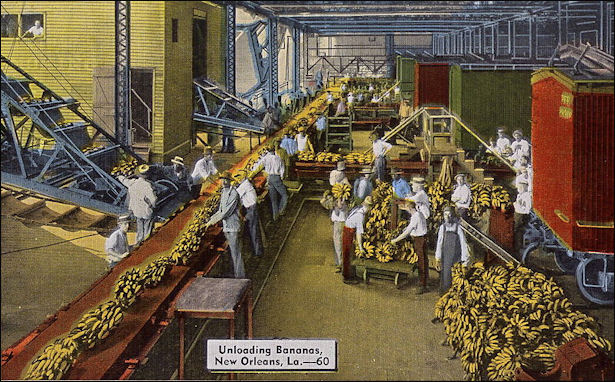
Bananas at Port New Orleans
Image Sources: Wikimedia Commons
Text Sources: National Geographic, New York Times, Washington Post, Los Angeles Times, Smithsonian magazine, Natural History magazine, Discover magazine, Times of London, The New Yorker, Time, Newsweek, Reuters, AP, AFP, Lonely Planet Guides, Compton’s Encyclopedia and various books and other publications.
Last updated June 2024

